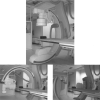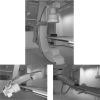3D rotational angiography: use of propeller rotation for the evaluation of intracranial aneurysms
- PMID: 15661720
- PMCID: PMC7975035
3D rotational angiography: use of propeller rotation for the evaluation of intracranial aneurysms
Abstract
We compared two methods of 3D digital subtraction angiography (DSA)--propeller and standard rotation--for the assessment of aneurysmal morphology and its relation to neighboring vessels. Aneurysms were correctly visualized and localized with both techniques. 3D DSA with propeller rotation technique seems to be effective and allows us to reduce the amount of contrast material related to a shortened acquisition time. Technical progress including propeller rotation allows a larger range of rotation and faster rotational speeds.
Figures


Similar articles
-
Digital subtraction rotational angiography for aneurysms of the intracranial anterior circulation: injection method and optimization.AJNR Am J Neuroradiol. 1996 Jun-Jul;17(6):1127-36. AJNR Am J Neuroradiol. 1996. PMID: 8791927 Free PMC article.
-
Three-dimensional volume rendering digital subtraction angiography in comparison with two-dimensional digital subtraction angiography and rotational angiography for detecting aneurysms and their morphological properties in patients with subarachnoid hemorrhage.Eur J Radiol. 2012 Oct;81(10):2794-800. doi: 10.1016/j.ejrad.2011.10.006. Epub 2011 Nov 4. Eur J Radiol. 2012. PMID: 22055683
-
Three-dimensional computed tomographic angiography in detection of cerebral aneurysms in acute subarachnoid hemorrhage.Neurosurgery. 1997 Jul;41(1):125-30. doi: 10.1097/00006123-199707000-00026. Neurosurgery. 1997. PMID: 9218304
-
[CT-angiography for diagnostic assessment of intracranial vascular aneurysms].Wien Med Wochenschr. 1997;147(7-8):163-71. Wien Med Wochenschr. 1997. PMID: 9297365 Review. German.
-
Computed tomography angiography for the detection and characterization of intra-cranial aneurysms: current status.Clin Radiol. 2005 Dec;60(12):1221-36. doi: 10.1016/j.crad.2005.06.007. Clin Radiol. 2005. PMID: 16291304 Review.
Cited by
-
Low-Dose 3D Rotational Angiography in Measuring the Size of Intracranial Aneurysm: In Vitro Feasibility Study Using Aneurysm Phantom.Neurointervention. 2021 Mar;16(1):59-63. doi: 10.5469/neuroint.2020.00437. Epub 2021 Feb 18. Neurointervention. 2021. PMID: 33596630 Free PMC article.
-
3D rotational angiography for the diagnosis and preoperative assessment of intracranial aneurysms: preliminary experience.Radiol Med. 2007 Sep;112(6):895-905. doi: 10.1007/s11547-007-0188-7. Epub 2007 Sep 20. Radiol Med. 2007. PMID: 17891340 English, Italian.
-
Three-dimensional rotational angiography for craniotomy planning and postintervention evaluation of intracranial aneurysms.Radiol Med. 2013 Apr;118(3):415-30. doi: 10.1007/s11547-012-0869-8. Epub 2012 Aug 8. Radiol Med. 2013. PMID: 22872461
-
Low-Dose Three-Dimensional Rotational Angiography for Evaluating Intracranial Aneurysms: Analysis of Image Quality and Radiation Dose.Korean J Radiol. 2022 Feb;23(2):256-263. doi: 10.3348/kjr.2021.0162. Epub 2022 Jan 4. Korean J Radiol. 2022. PMID: 35029071 Free PMC article.
-
Computed tomographic angiography as an adjunct to digital subtraction angiography for the pre-operative assessment of cerebral aneurysms.Open Neurol J. 2009 Jan 28;3:1-7. doi: 10.2174/1874205X00903010001. Open Neurol J. 2009. PMID: 19452029 Free PMC article.
References
-
- Anxionnat R, Bracard S, Macho J, et al. 3D angiography: clinical interest—first applications in interventional neuroradiology. J Neuroradiol 1998;25:251–262 - PubMed
-
- Carsin M, Chabert E, Croci S, Romeas R, Scarabin JM. The role of 3-dimensional reconstructions in the angiographic evaluation of cerebral vascular malformations: 3D morphometry. J Neuroradiol 1997;24:137–140 - PubMed
-
- Gattoni F, Sacrini A, Tonolini M, Melgara C, Uslenghi CM. Digital rotational angiography in the study of vascular diseases: technical note and initial clinical applications. Radiol Med (Torino) 1998;96:570–573 - PubMed
-
- Missler U, Hundt C, Wiesmann M, Mayer T, Bruckmann H. Three-dimensional reconstructed rotational digital subtraction angiography in planning treatment of intracranial aneurysms. Eur Radiol 2000;10:564–568 - PubMed
Publication types
MeSH terms
LinkOut - more resources
Full Text Sources
Medical
